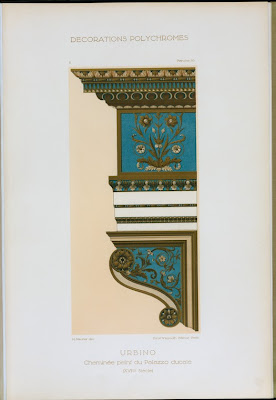Ceiling design from the Palazzo Scrofa-Calcagnini in Rome*
(*Does anyone know another name for this? There are scant details online and what there is suggests it's in Ferrara.)

Mosaic detail from the Bardo Museum in Tunis (plate by Homolka)

Detail of painted fireplace ornament from Palazzo Ducale in Urbino
- Wikipedia
- Flickr (ducale + urbino)
- Official site (in Italian)

Lunette decoration from Palazzo Ducale in Mantua, Lombardy

Correggio's 1518 vault fresco in St Paul's convent (Camera di San Paolo) in Parma

Ceiling painting from the Hotel de Ville in Prague
(I presume this is from the new town hall building [Novoměstská Radnice] but I'm not sure. Anyone?)

Giulio Romano's 16th century dome painting in Villa Madama in Rome

Design of the vault cap in Fugger House, Augsburg
The Fugger family were similar to the Medicis of Florence: rich and influential patrons with extensive property, so it's hard to identify the specific building containing the ceiling vault in the above lithograph.

16th century panel design from Trausnitz Castle, Landshut, Bavaria
- Burg Trausnitz homepage (more in the German section)
- Pbase photo gallery by Scott
- Wikipedia / Bavarian Palace Dept.

Frieze and column decoration details from Great St Martin Church in Cologne
- Wikimedia photo gallery
- Wikipedia (in German) [translation]

Ceiling painting from Uffizi Gallery in Florence
- Official site (in English)
- Wikipedia

Door and surround from the room where
Louis XIII was born at Fontainebleau Palace
Louis XIII was born at Fontainebleau Palace
[click images for larger versions; mouseover for original French captions; English captions are my approximatations]
In his 2-volume work, 'Décorations Polychromes', artist Ernst Ewald assembles what amounts to a grand tour through some of the most important elements from the decorative arts output of the Renaissance, found in buildings from Europe (and North Africa).
The one hundred and forty sumptuous illustrations are chromolithographs and the array of colours and tones present suggests that this was a complex and protracted printing process. The work was published somewhere between 1889 and 1896, perhaps aimed at a declining revivalist market (see: neo-Renaissance), or simply as an up-to-date record using the most realistic means of reproduction then available.
- The great majority of the illustration plates from 'Décorations Polychromes' are available from the NYPL Digital Gallery.
- Ernst Ewald at Wikipedia (in German) [translation]
Same ballpark, different tangent: the rich 'Imago Urbis: Giuseppe Vasi’s Grand Tour of Rome' site from the University of Oregon is well worth a timesink:
"Giuseppe Vasi’s Grand Tour presents an innovative geo-database (geographic database) and website that references the work of two 18th century masters of Roman topography: Giambattissta Nolli (1701-1756), who published the first accurate map of Rome (La Pianta Grande di Roma, 1748); and his contemporary and Giuseppe Vasi (1710-1782), whose comprehensive documentation of the city and its monuments, especially in Delle Magnficenze di Roma antica a moderna, published from 1747-1761, establishes him as one of Rome’s great topographers."




















3 comments :
"Ceiling painting from the Hotel de Ville in Prague
(I presume this is from the new town hall building [Novoměstská Radnice] but I'm not sure. Anyone?)"
I thought I was going to have a fast answer for you, but I discovered I was thinking of the wrong building, namely the new radnice in the Old Town, not the New Town radnice. Sorry.
Just a further clarification (having looked a bit more)... the new radnice (town hall) that I had in mind was the building at Mariánské 1 across from the Klementinum and the municipal library, which was done from designs by Polívka in 1912 and has a surprising amount of sculptural ornament by Sucharda, Mařatka, and Šaloun... it took over from the old radnice which was damaged in 1945 by the Germans. The building to which you refer (which may or may not have the ceiling painting) is centuries older and a short walk away. Someone who's been inside that one more recently will have to comment.
"Ceiling design from the Palazzo Scrofa-Calcagnini in Rome"
If the design comes from Palazzo Scrofa Calcagnini, then it is in Ferrara.
The duke of Milan Ludovico Sforza (Ludovico "The Moor") entrusted Antonio Costabili with the building of a palace in Ferrara, which later became property of Costabili's family and afterwards in part of the Calcagnini family, in part of the Scrofa family.
Post a Comment
Comments are all moderated so don't waste your time spamming: they will never show up.
If you include ANY links that aren't pertinent to the blog post or discussion they will be deleted and a rash will break out in your underwear.
Also: please play the ball and not the person.
Note: only a member of this blog may post a comment.